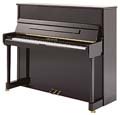Piano Dehumidifier
Do you need a piano dehumidifier? A better question might be, "do I need to control the humidity around and inside my piano?" In this article I will explain why humidity control for your piano is essential and how the Piano Life Saver and other humidity control appliances can help.
Why is Humidity Control Important?
This is an important question for you if
you have invested a substantial sum of money in a high quality piano
and either you, or a family member, play the instrument. Many of you will know the answer but a
word of explanation may be helpful for
those who don't.

As we all know pianos have many wooden parts. Piano manufacturers have
not overlooked new technologies and materials and have introduced a
range of them over the years to improve quality and lower costs.
The
fact remains that no other material, whether natural or synthetic, has
so far been found which can compare with wood, from a variety of tree
species, to produce the quality of sound we want.
The main problem with wood is that it is porous and will absorb water from the air when humidity is high and release it again when humidity is low. As we all know wetting and drying wood repeatedly will cause it to expand and contract, to warp, and even crack.
In the
case of a piano this can result in problems. The wooden soundboard of
the piano is not flat; it has an arch, known as a "crown". The crown
gets a little larger or smaller with changes in its moisture content.
This changes the tension on the strings the piano goes out
of tune. The more extreme the fluctuations and the more occasions on
which they occur the more likely it is that the soundboard will need to
be re-built or the entire instrument replaced.
Big changes in humidity can affect other wooden parts of your instrument too
but there is no need to dwell on them. All piano experts agree that
excessive changes in humidity are harmful to your piano and that,
therefore, humidity needs to be controlled.
How Can We Control the Humidity?
The ideal relative humidity for a piano is 42% and most piano
manufacturers recommend maintaining a range of 40% to 50% relative
humidity.
That range may not be achievable in some circumstances but most informed commentators agree that it is more important to limit the range in which humidity changes than it is to stay within the recommended upper and lower limits. In other words if you can keep humidity within a range of, say 50-60%, that is better than 40-55%.
This
is why the question at the top of this page was rephrased. This is
not just a question of using a piano dehumidifier; we also need a piano
humidifier. Too low a level of relative humidity is just as harmful as
one that is too high.
There are two aspects to this problem.
The Room Where the Piano is Kept
The terms piano dehumidifier and piano humidifier only apply in this
context because they are being bought specifically to control humidity
around the piano. They are straightforward domestic devices.
If you live in an area where high or low relative humidity is the norm
you will only need one of these appliances but for most people a piano
dehumidifier will be needed during the humid parts of the year and a
humidifier for the times when the air is too dry.
The piano dehumidifier and/or humidifier
you purchase must have the capacity to sense the relative humidity in
the room and to switch on or off when the threshold is achieved. The
device that performs this function is called a humidistat.
Since you need a piano dehumidifier and humidifier you can rely on, it is advisable to purchase from a reputable manufacturer and not simply buy the cheapest; but neither do you need the most expensive, with all the bells and whistles.
Apart from the humidistat there are three important things to consider:
- Capacity
- the piano dehumidifier or humidifier should be able to cope
comfortably with the size of room in which you wish to use it.
- Auto-restart - if there
should be a power outage you will want the machine to restart
automatically when the power is restored.
- Quietness - less important for some but essential for most musicians. Look for a machine that is reported by users to be quiet.
The Piano Itself
There is on the market a system which fits, out of sight, in the piano
itself. It is a combination of piano dehumidifier and piano
humidifier, controlled by a humidistat, which maintains the interior of
the piano at the optimum level of relative humidity. You can see the
components of this system in the image below.

It is called the "Piano Life Saver" and is manufactured by Dampp-Chaser.
Its
advantages are its precision and unobtrusiveness. Its principal
disadvantage is cost. It can only be supplied by a licensed installer
and costs several hundred dollars in the US or pounds in the UK.
It
is not an alternative to the domestic devices; rather it is an
enhancement, a second line of defence. If your budget will not run to
both we recommend that you control humidity in the room first and only
add an internal piano dehumidifier if and when resources allow.
You are here....Home > Choosing > Piano Dehumidifier
Search our Site
Frequently Asked Questions
Need an answer? Try our
Ask a Question
Click here to ask
Make a Comment
Click here to leave your
Comments






